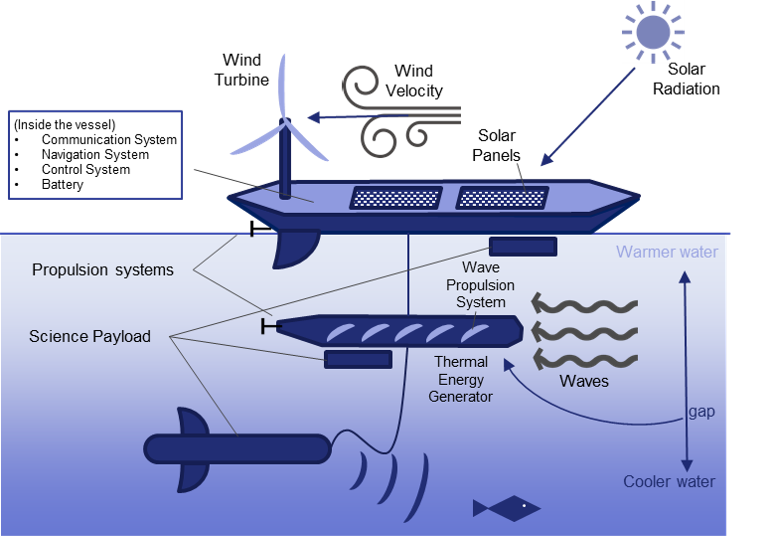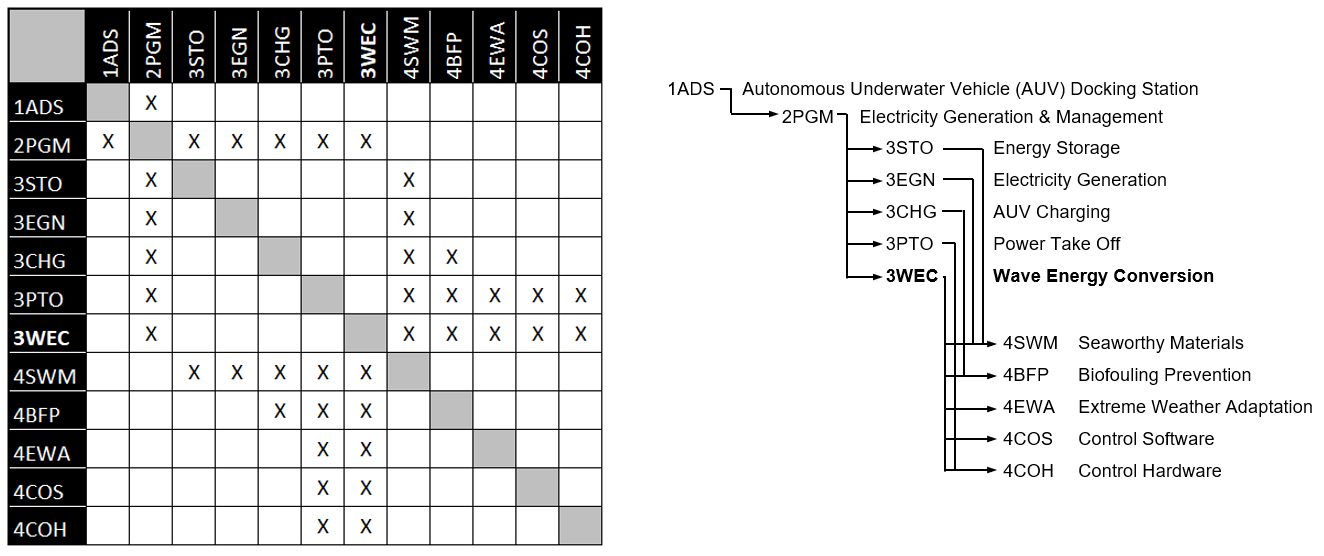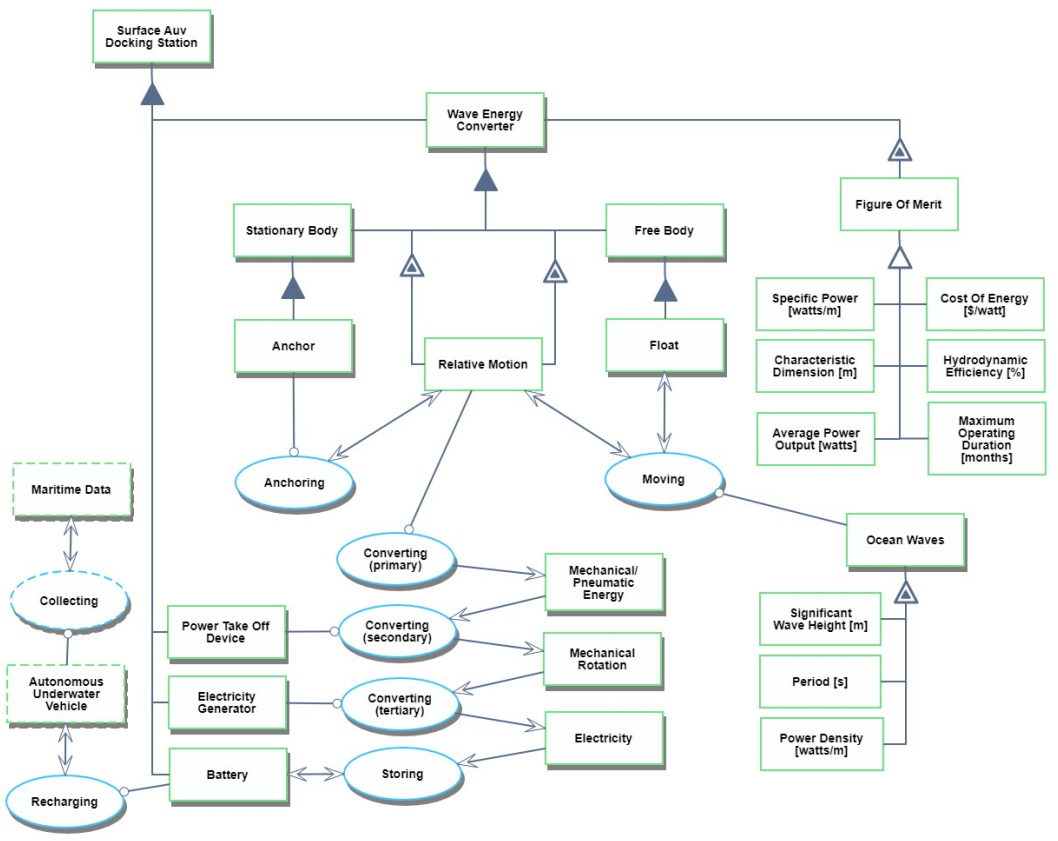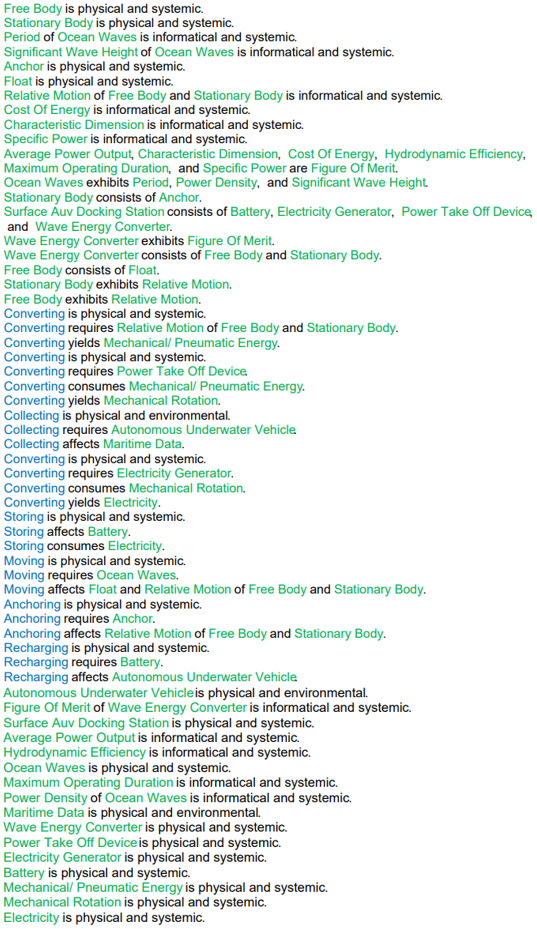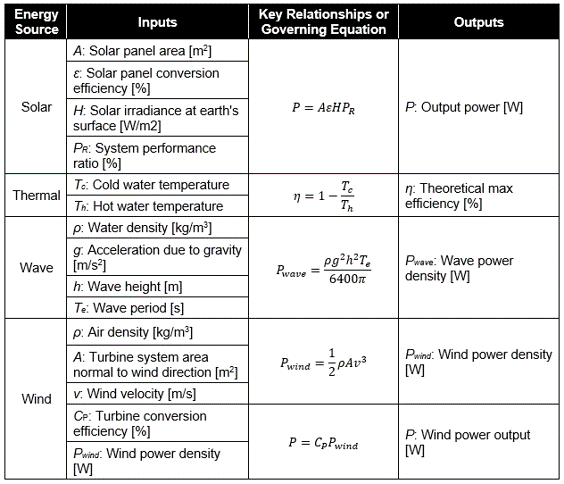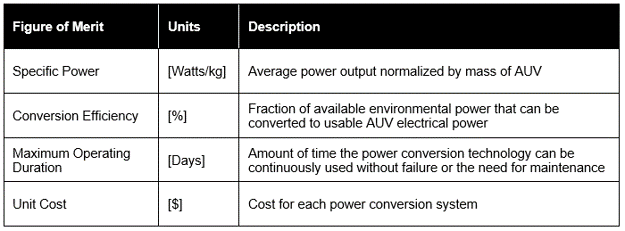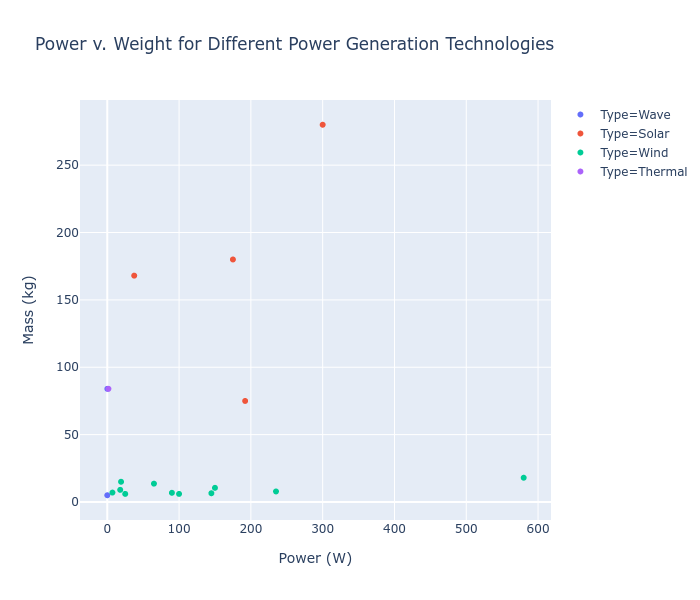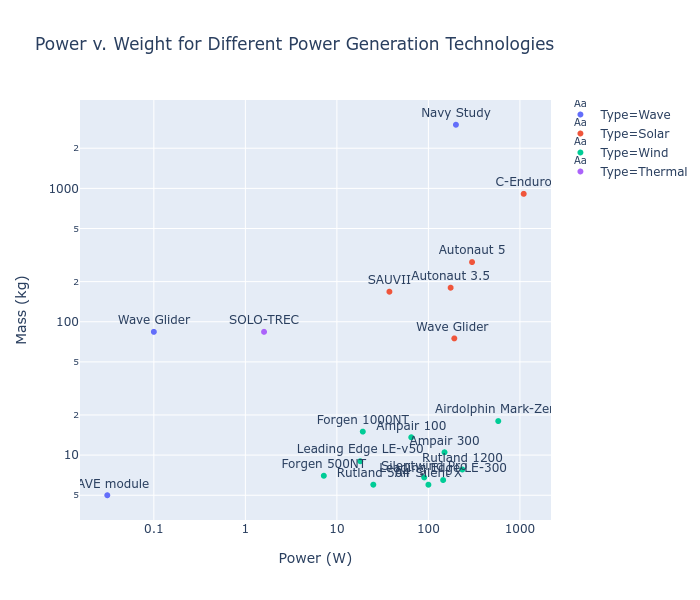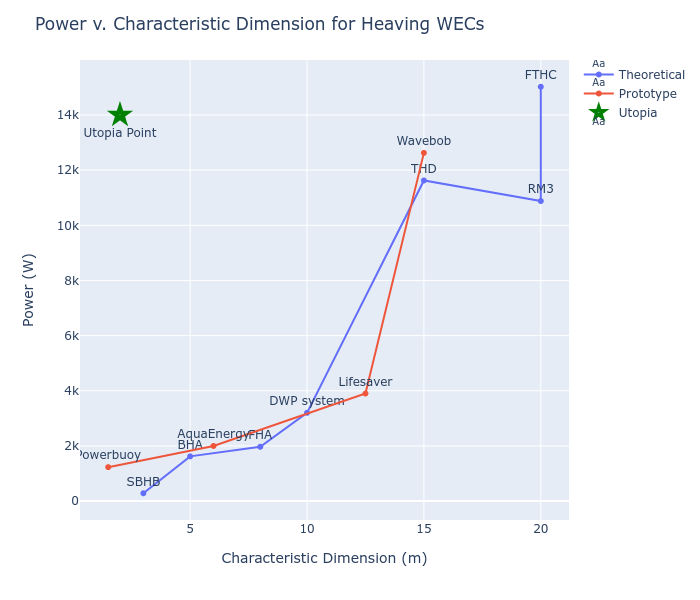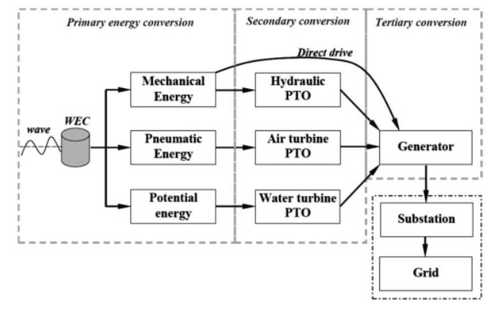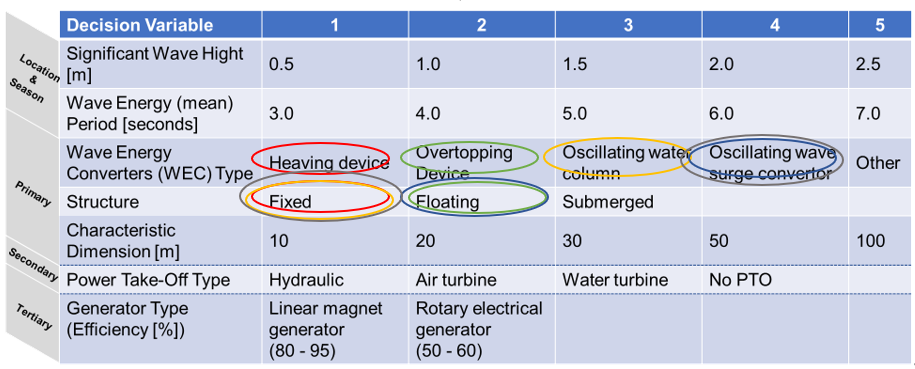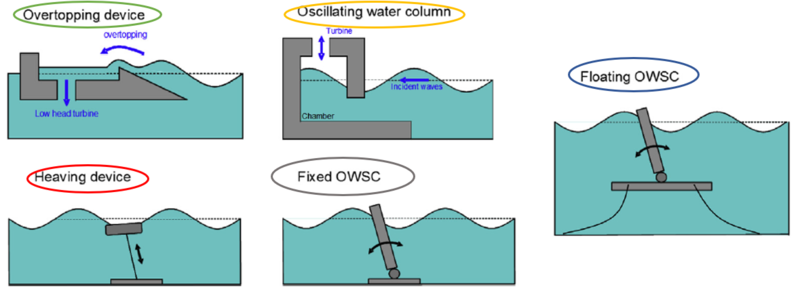Difference between revisions of "In-Situ Power Generation for AUVs"
| Line 171: | Line 171: | ||
===Baseline Case=== | ===Baseline Case=== | ||
Revision as of 16:32, 17 November 2020
Technology Roadmap Sections and Deliverables
This is a technology roadmap for:
- 4GEN - In-Situ Power Generation
This is a “Level 4” roadmap, indicating that it addresses a technology at the subsystem component level. Higher level roadmaps related to this subject would address technology progression at the market level (Ocean Exploration), product level (AUV), and subsystem level (Power System).
Roadmap Overview
Autonomous underwater vehicles (AUV) are widely used to make observations and make sense of the ocean without the limitation of requiring a human-in-the-loop to function. Despite advancements in battery and other energy storage technologies, power availability remains a key limiting factor for many AUVs. Power constraints limit payload capabilities, reduce design trade space for key functions like communication and navigation, and restrict the reach of AUVs by reducing mission durations and preventing access to remote areas of the ocean. Despite its austerity, the ocean offers abundant sources of environmental energy in the form of wind, solar, waves, and thermal gradients that can be harvested with the right technology. The figure below shows a notional autonomous maritime system that utilizes each of these energy sources to provide an in-situ power generation capability.
Design Structure Matrix (DSM) Allocation
The 4GEN tree shown above reveals that in-situ power generation (4GEN) is an enabling technology for the power (3POW) and propulsion (3PRO) subsystems that, together with communication (3COM), navigation (3NAV), control (3CON), and payload (3PAY) subsystems, form the persistent AUV (2PAO) product. Enabling technologies for in-situ power generation are energy conversion technologies for wave (5WAV), thermal (5THE), solar (5SOL), and wind (5WIN) energy. 4GEN is a direct enabling technology for the propulsion subsystem because some forms of wave energy conversion allow direct conversion to propulsive force without the need for conversion to electrical energy.
Roadmap Model using OPM
The Object-Process Diagram (OPD) in the figure below shows how the 4GEN technology is related to the broader persistent AUV system. The diagram shows the AUV and its constituent subsystems including the power subsystem, which consists of an energy conversion device that is the physical embodiment of 4GEN technology. As is shown in the diagram, 4GEN technology acts as the instrument that converts environmental thermal, wave, wind, and solar energy into usable energy that is used by the AUV to power its subsystems. The figure also depicts the maritime data collection function, which is the primary purpose of the AUV. Figures of merit (FOM) characterizing the energy generation technology are also shown.
An Object-Process Language (OPL) associated with the OPD is auto-generated and is shown below. It reflects the same content as the previous figure in narrative form.
Figures of Merit
The following table shows figures of merit (FOM) that can be used to characterize in-situ AUV power generation technology. Each FOM provides unique information: specific power offers insight into likely power output when integrated into a host system, conversion efficiency provides information about how much the technology can still be improved before the theoretical maximum is reached, maximum operating duration reveals how readily the technology can support persistent AUV operations, and unit cost provides insight into economic feasibility.
The following table shows important relationships and governing equations related to this technology for each of the in-situ energy sources. They are used to understand the richness of a source of environmental power, as well as calculate how much of that energy can be converted to usable AUV energy.
The following plots show specific power of various in-situ energy sources chronologically, as well as a comparison of reported power output to total vehicle mass for various autonomous maritime system that utilize at least one in-situ energy source.
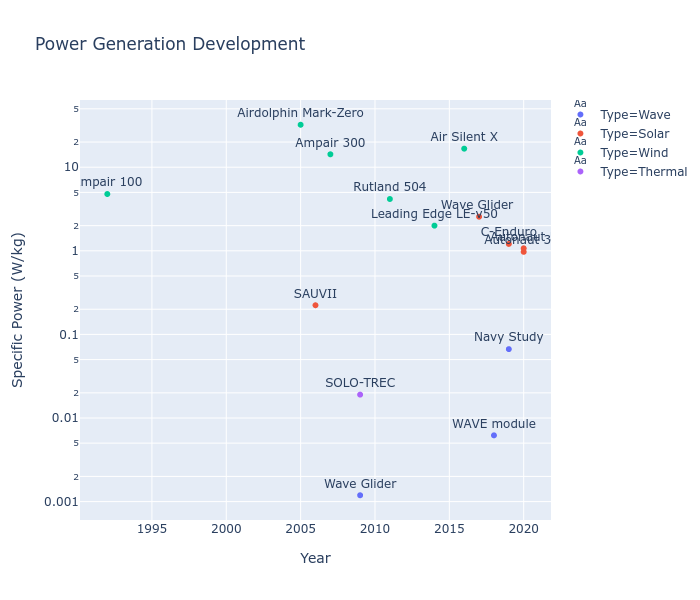
Alignment with Company Strategic Drivers
The following table shows our strategic drivers and the alignment of those drivers with this roadmap.
| Number | Strategic driver | Targets and Alignment |
|---|---|---|
| 1 | Deliver a portable offshore wave energy conversion system with enough capacity to sustain large-class (>500kg) AUV operations. | Target: Generate an average of 5kW of electrical power using a device with a maximum characteristic width of 5m.
Increasing wave energy conversion efficiency at a deployable size is the focus of this roadmap, therefore this strategic driver is aligned with the technology roadmap. |
| 2 | Increase the quantity of data an AUV payload collects by increasing the operating-to-docking duty cycle rate. | Target: AUV in collection operations 50% of the time.
For a system comprised of one AUV associated with a single ocean surface docking station, AUV duty cycle depends on the rate of energy generation, the rate that energy can be transferred to an AUV when it is docked for energy replenishing, and the quantity of energy an AUV can store. This roadmap only addresses the rate of docking station power generation. Therefore, this strategic driver is aligned with the technology roadmap, but other technology development is required to fully achieve this strategic driver’s target. |
| 3 | To provide a system capable of continuous unattended operation to enable maritime data collection in remote oceanic regions with minimal support infrastructure. | Target: 1 year of continuous autonomous operation.
Our roadmap focuses on increasing the efficiency with which wave power can be converted to useful power. This objective will result in the incorporation of new wave energy transfer technologies that are untested over extended operations. Additionally, this roadmap does not address potential maritime-specific failure mechanisms like biofouling or extreme weather. Therefore, this strategic driver is not aligned with the technology roadmap. |
As the table shows, the roadmap for wave energy conversion technology is not sufficient by itself to enable a reliable offshore power source for long-duration unattended AUV maritime data collection operations.
Positioning of Company vs. Competition
There are a wide variety of heaving buoy wave energy converters. The table below summarizes the key data points about each model.
| Name | Hydrodynamic Efficiency (%) | Characteristic Dimension (m) | Average Power (kW) | Year | |
|---|---|---|---|---|---|
| Point Absorber | 14 | 125 | 28 | 2002 | |
| DWP System | 20 | 10 | 3.2 | 2002 | |
| AquaEnergy | 18 | 6 | 1.9 | 2004 | |
| INRI/SEADOG | 19.25 | 5.7 | 1.9 | 2004 | |
| Wavebob | 45.5 | 15 | 12.8 | 2004 | |
| Small bottom-referenced heaving buoy (SBHB) | 3.75 | 3 | .2 | 2012 | |
| Floating two-body heaving converter (FTHC) | 29.75 | 20 | 15 | 2012 | |
| Bottom-fixed heave-buoy array (BHA) | 14.75 | 5 | 1.6 | 2012 | |
| Floating heave-buoy array (FHA) | 9.75 | 8 | 3.2 | 2012 | |
| Two-body heaving device (THD) | 25 | 15 | 11.6 | 2012 | |
| Lifesaver | 12 | 12.5 | 3.9 | 2014 | |
| RM3 | 16 | 20 | 11 | 2013 | |
| DEXA | 8 | 22 | 4.6 | 2012 | |
| Powerbuoy | 44 | 1.5 | 1.2 | 2017 |
Below, we can see two of our FOMs compared graphically. We show two series. The red line shows actual heaving wave energy converter prototypes tested in actual ocean conditions, whereas the blue line shows numerical analysis using modeling equations. The two data series generally agree about the current performance of heaving WECs.
In accordance with strategic driver 1, we want to shift the Pareto front to the top left, where we get more power with a smaller form factor (lower characteristic dimension).
Technical Model
There are various ways to convert the wave energy, and the amount of energy significantly changes depending on the wave's situation. For simplicity, we divide the model into three parts: 1)the wave energy converter (WEC) part, which converts the wave energy as mechanical, pneumatic, or potential energy, 2)the power take-off (PTO) part, which converts absorbed energy into useful mechanical energy, and 3) the generator, which transforms useful mechanical energy into electrical energy.
As will be shown later, the wave energy converted by the WEC is determined by the significant wave height and the wave energy period, which vary with the location and season, and the characteristic dimension, which is the length that wave passes. WECs can be broadly classified into the following categories: heaving device, overtopping device, oscillating water device, oscillating wave converter, and others. Each type of WEC includes those whose structures are fixed to the seabed or the shore, floating, and submerged in the water.By adding the secondary and tertiary conversion options to the above information Morphological Matrix and Tradespace are shown as follows. Note that the secondary and tertiary conversions are outside the scope of this roadmap.
The image of each WEC type is as follows. The choices shown as ellipses in the matrix correspond to each type.
The coefficients affecting the energy conversion efficiency by WEC type differ as follows. In this roadmap, we focus on the mathematical model of the having device to deepen the discussion.
Some important variables:
- B = Characteristic Dimension [m]
- A = Maximum Horizontal Cross-sectional Area of the WEC device [m^2]
- H = Significant Wave Hight [m]
- T = Wave Energy (mean) Period [seconds]
- η = Hydrodynamic Efficiency [%]
- ρ = Water Density [kg/m^3] (≈1000 kg/m^3 )
- g = Gravitational Constant [m/s^2] (≈ 9.81 m/s^2)
Key equations:
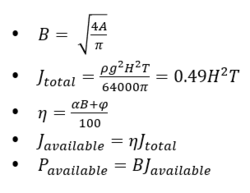
Assuming that we use the heaving device, which has a spherical floating device, the power converted by the WEC is given by:
Also, based on Budal’s limit, the upper theoretical limit for power generation is given by:
Key Publications and Patents
Key publications and patents are listed below. The listed publications were used to understand current wave energy convertor performance, review modeling methodologies for AUV recharging using wave energy, and determine how this roadmap's technology could be used in a market application. The patents listed represent the first document instance of this type of wave energy conversion technology, as well as several incremental improvement features to increase efficiency and utility.
Publications
- Babarit, Aurélien. "A database of capture width ratio of wave energy converters." Renewable Energy 80 (2015): 610-628. Executive Summary: Comprehensive compilation of wave energy convertor performance scaled to device characteristic width. Establishes wave energy extraction performance by convertor type and device characteristic width using data regression.
- Aderinto, Tunde, and Hua Li. "Review on power performance and efficiency of wave energy converters." Energies 12.22 (2019): 4329. Executive Summary: Review and comparison of reported hydrodynamic efficiencies and power performance of wave energy convertors across a range of convertor types and sizes. The analysis concludes that the oscillating body type of wave energy convertor currently has the highest efficiencies, and that efficiency can be further improved by matching the conversion system dynamics to local wave conditions to maximize power output.
- Driscol, Blake P., L. Andrew Gish, and Ryan G. Coe. "A Scoping Study to Determine the Location-Specific WEC Threshold Size for Wave-Powered AUV Recharging." IEEE Journal of Oceanic Engineering (2020). Executive Summary: Feasibility analysis of wave energy in a AUV recharging application using reported wave energy convertor performance and observed ocean wave energy data. The study concludes there is sufficient available wave energy in the studied locations to support AUV recharging operations using modestly-sized wave energy convertors.
- LiVecchi, A., et al. "Powering the blue economy; exploring opportunities for marine renewable energy in maritime markets." US Department of Energy, Office of Energy Efficiency and Renewable Energy. Washington, DC (2019): 207. Executive Summary: United States Department of Energy report exploring scientific, military, and commercial markets where marine energy may be uniquely suited to meet market needs. The report explores opportunities and potential applications of one such market—underwater vehicle recharging—which is expected to double by 2022.
Patents
- Gehre, Max. (1899). US Patent No US628457A. “Device for producing electric currents at sea by the action of waves” available on https://patents.google.com/patent/US628457A. Executive Summary: The first known US patent for a heaving point absorber type of wave energy convertor that generates electricity at the wave site. The simple device uses a simple float to induce electrical current through one-dimensional motion between a series of magnets and an induction coil.
- Dick, William, (2001). US Patent No US6857266B2. “Wave energy convertor” available on https://patents.google.com/patent/US6857266B2. Executive Summary: The described device is for a typical heaving point absorber type of wave energy convertor that includes the novel feature of being able to variably tune the oscillation device to match the wave period, a key current research area of wave energy conversion technology.
- Foster, Graham and Stockman, Gareth, (2009). US Patent No US8826658B2. “Wave powered generator” available on https://patents.google.com/patent/US8826658B2. Executive Summary: A patent for a point absorber type of wave energy conversion device that incorporates features that make each convertor more easily transportable, such as an inflatable float and non-rigid connectors between pieces of the device.
Financial Model
Baseline Case
| Model Parameter | Value | Rationale |
|---|---|---|
| Discount Rate [%] | 10% | Moderate Risk Project |
| Average wave power density [kW/m] | 20 | Estimated worldwide average |
| Characteristic width [m] | 5.0 | Target conversion device size based on company strategic drivers |
| Power generation efficiency [%] | 12% | Expected efficiency for this characteristic dimension based on technical model |
| Power take-off efficiency [%] | 80% | Estimated for linear power take-off technique |
| Electricity generation efficiency [%] | 40% | Estimated for hydraulic turbine generator |
| Mean time before failure [years] | 0.5 | Estimated |
| Repair cost [$1000] | $20 | Estimated |
| Starting unit production cost [$1000] | $2,000 | Estimated based on limited reporting for current prototype designs |
| Starting sales price [$1000] | $2,100 | Estimated based on production cost value |
| Operating life [years] | 5 | Estimated |
| Production learning rate [% per year] | 5.0% | Estimated. Large gains expected due to newness of WEC production sector. |
| Demand factor [-] | 2 | Estimated |
| Cost factor [-] | 0.001 | Estimated |
| Annual market growth [% per year] | 10% | Estimated based on Department of Energy market growth projection |
| Total R&D cost [$1000] | $20,000 | Estimate based on current reporting for current WEC prototypes |
Improved Performance Through R&D Case
Technology Strategy Statement
Our target is to develop a new heaving wave energy converter that can support continuous AUV operations in any ocean environment by 2030.
